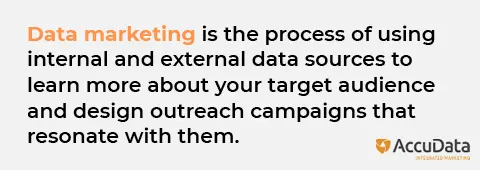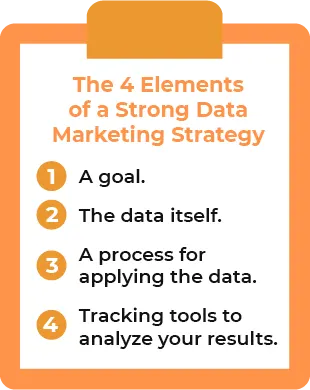
How well do you know your nonprofit’s audience? As a fundraising professional, you know the importance of understanding your audience in order to market to them effectively. You might have a vague sense of who your supporters are and what matters to them, but struggle to pinpoint the right ways to connect with them.
That’s where data comes into play. Data helps you get to know your audience on a personal level, understanding their likes, dislikes, communication preferences, ambitions, and more.
You may be interested in putting your data to work by adopting a data marketing strategy. Data marketing is a growing fundraising trend that allows your organization to make the most of its outreach efforts.
In this quick guide, we’ll explore everything your organization needs to know to get started with data marketing in the following sections:
- Data Marketing Definition
- Benefits of Data-Driven Marketing for Your Nonprofit
- The 4 Elements of a Strong Data Marketing Strategy
Ready to learn more about how data marketing can boost your organization’s fundraising success? Let’s get started.
Data Marketing Definition
AccuData defines data marketing as the process of using internal and external data sources to learn more about your target audience and design outreach campaigns that resonate with them.

These data sources can reveal information about supporters such as their:
- Buying habits
- Donation history
- Demographics
- Interests
- Communication preferences
- Lifestyles
For example, let’s say you’re planning a virtual 5K fundraiser and want to expand the event’s audience to include a wider array of younger participants. You can use data marketing to identify these specific supporters and craft marketing materials that speak to their interests. By filtering your nonprofit database based on age, you can identify younger supporters and spark their interest with a social media campaign.
Benefits of Data-Driven Marketing for Your Nonprofit
The principal benefit of using data marketing is that it boosts the effectiveness of your marketing campaigns. You won’t waste time or money marketing to individuals who aren’t interested in your organization.
Here are some additional advantages of this strategy:
- Reach your target audience more effectively. You’ll be able to identify the right communication platforms to use to reach different audience segments. For instance, if you’re hoping to target an audience of college-age individuals, you might launch a text-to-donate campaign to reach them on their mobile devices.
- Improve your return on investment. You can connect with an audience that’s more likely to engage with your content because it appeals to their interests.
- Measure success using clear key performance indicators (KPIs). Data marketing provides access to a variety of predictive metrics that give you solid benchmarks to measure your progress. You can assess your past performance and also predict future trends.
Data-driven marketing allows you to base your advertising strategy on hard facts, rather than hunches.
The 4 Elements of a Strong Data Marketing Strategy
To craft an effective data marketing strategy, you’ll need more than just the data points themselves. Data marketing requires a strategic approach to choosing, analyzing, and applying data to help reach specific marketing goals.
With this in mind, here are the four main elements of a powerful data marketing approach:

Element #1: A goal.
What are you hoping to achieve through data marketing? Your goals might include:
- Reaching out to a new audience demographic, such as members of Gen Z or retirees.
- Connecting with a local audience.
- Exploring new marketing channels, such as geofencing or social media.
- Finding the right individuals to participate in more active support roles, such as peer-to-peer fundraising or volunteering.
Once you’ve established your goals, you can determine which data points will be the most useful and relevant to analyze.
Element #2: The data itself.
Next, it’s time to choose the data points that will help inform your marketing analysis. There are two main data sources you can explore to find the right data points:
- Internal data: This is the data your organization collects from its ongoing interactions with supporters. Sources for this data include your online donation page, email marketing platform, supporter surveys and interactions, and other in-house sources.
- External data: This is data gathered from third-party sources such as online prospect research tools, prospecting lists, and consumer research firms.
Before you can analyze internal data or invest in external information, your internal database must be clean and organized. You can keep your database clean using a proactive approach called data hygiene.

Data hygiene best practices include:
- Regularly auditing your database to identify issues
- Removing unhelpful or inaccurate information
- Establishing data entry best practices to ensure your data remains organized
Review Re:Charity’s data hygiene guide for more best practices to follow, including tips for working with data management experts.
In addition to data hygiene, many data management firms offer services such as batch data updates of addresses and phone numbers, as well as data append. This is the process of enhancing your internal database to fill in any missing information, such as phone numbers or email addresses. You can also append descriptive information such as supporters’ previous philanthropic involvement, employment statuses, and net worth.
If you find missing data throughout your database audit, conducting a data append can help round out your records. This provides a fuller picture of your audience to help support your marketing research (and ensures you have a reliable way to get in touch with supporters, too!).
Element #3: A process for applying the data.
Once your database is clean and complete, start applying your data insights to help reach your marketing goals. Follow these steps to apply your data effectively:
- Decide which demographics or supporter characteristics will be most beneficial for your fundraising or marketing goals. For instance, if you’re looking to connect with a local audience, geographic data would be one of the most important metrics to analyze.
- Segment your database according to those traits to find your target audience. Apply filters to your database to discover which individuals align with your target audience’s characteristics. Group supporters based on these shared characteristics.
- Craft marketing materials that appeal to the interests of your target audience. Use targeted marketing strategies such as email marketing, paid social media advertising, geofencing marketing, and direct mail outreach to connect with your target market. Also, use audience demographics to determine the right platforms to use. For example, you might use social media to connect with a young adult audience and email to connect with a slightly older, professional audience.
You can repeat this process no matter what your goal is.
Element #4: Tracking tools to analyze your results.
Choose several key performance indicators (KPIs) to measure to determine your data marketing success. This can reveal your most and least effective strategies and how you should change your approach for greater success in the future.

Choose relevant analytics to track such as:
- Email open rate: This is the number of supporters who open your email messages.
- Email click-through rates: This metric shows how many email recipients click through the links in your emails to visit your website.
- Website page views: This is the number of times visitors click on your website.
- Social media engagement: This metric includes relevant social media analytics such as the number of likes, shares, comments, and views your posts receive.
- Conversion rate: The conversion rate is the percentage of individuals who take the desired action, such as donating with your fundraising page or signing up for a volunteer opportunity.
Adopt a continuous improvement approach to your data marketing strategy. You can use A/B testing to determine which forms of outreach are most effective. In this case, A/B testing involves creating two different versions of the same marketing message and determining which is more engaging for supporters. For example, you can create different versions of your paid social media ads or use slightly different email subject lines to decide which strategy to move forward with.
Data marketing is an effective way to learn more about your nonprofit’s supporters, meet them where they are, and connect with them in ways that resonate with their personal interests.
If your organization needs a helping hand to sort out your database, investigate your options for working with a database management firm. These professionals will help ensure your database is organized and complete so that you can conduct your data marketing efforts with more certainty. Good luck!

Guest Author: Gabrielle Perham, MBA, Director of Marketing – Gabrielle is the Director of Marketing for AccuData Integrated Marketing. She joined the organization in 2017 and possesses more than 15 years of experience in strategic marketing, branding, communications, and digital marketing. She earned a B.S. in Marketing and an M.B.A in Marketing Management from the University of Tampa.



